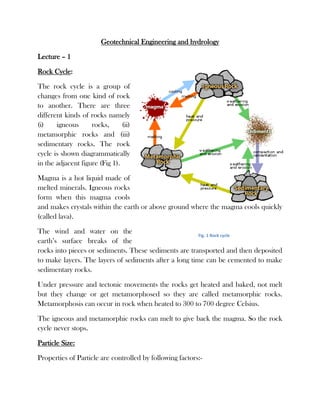
Geotechnical Engineering and hydrology for Engineers
- 1. Geotechnical Engineering and hydrology Lecture – 1 Rock Cycle: The rock cycle is a group of changes from one kind of rock to another. There are three different kinds of rocks namely (i) igneous rocks, (ii) metamorphic rocks and (iii) sedimentary rocks. The rock cycle is shown diagrammatically in the adjacent figure (Fig 1). Magma is a hot liquid made of melted minerals. Igneous rocks form when this magma cools and makes crystals within the earth or above ground where the magma cools quickly (called lava). The wind and water on the earth’s surface breaks of the rocks into pieces or sediments. These sediments are transported and then deposited to make layers. The layers of sediments after a long time can be cemented to make sedimentary rocks. Under pressure and tectonic movements the rocks get heated and baked, not melt but they change or get metamorphosed so they are called metamorphic rocks. Metamorphosis can occur in rock when heated to 300 to 700 degree Celsius. The igneous and metamorphic rocks can melt to give back the magma. So the rock cycle never stops. Particle Size: Properties of Particle are controlled by following factors:- Fig. 1 Rock cycle
- 2. i. Transportation: The common mechanisms of transport are the actions of gravity, ice, water, and wind. Wind-blown soils include dune sands and loess. Water carries particles of different size depending on the speed of the water, thus soils transported by water are graded according to their size. Silt and clay may settle out in a lake, and gravel and sand collect at the bottom of a river bed. Wind-blown soil deposits (Aeolian soils) also tend to be sorted according to their grain size. Erosion at the base of glaciers is powerful enough to pick up large rocks and boulders as well as soil; soils dropped by melting ice can be a well graded mixture of widely varying particle sizes. Gravity on its own may also carry particles down from the top of a mountain to make a pile of soil and boulders at the base; soil deposits transported by gravity are called colluvium. The mechanism of transport also has a major effect on the particle shape. For example, low velocity grinding in a river bed will produce rounded particles. Freshly fractured colluvium particles often have a very angular shape. ii. Porosity: Porosity is the ratio of pore volume to its total volume Porosity is controlled by: rock type, grain size, pore distribution, cementation, diagenetic history and composition. Rocks normally decrease in porosity with age and depth of burial Tertiary age Gulf Coast sandstones are in general, more porous than Cambrian age sandstones. There are exceptions to this rule, usually because of the depth of burial and thermal history. iii. Cohesion: Cohesion is the component of shear strength of a rock or soil that is independent of interparticle friction. In soils, true cohesion is caused by one of three things: 1. Electrostatic forces in stiff over consolidated clays (which may be lost through weathering) 2. Cementing by Fe2O3, CaCO3, NaCl, etc. 3. Root cohesion (which may be lost through logging or fire of the contributing plants, or through solution) There can also be apparent cohesion. This is caused by: 1. Negative capillary pressure (which is lost upon wetting) 2. Pore pressure response during undrained loading (which is lost through time) iv. Surface area to volume ratio: The surface-area-to-volume ratio also called the surface-to-volume ratio and variously denoted sa/vol or SA:V, is the
- 3. amount of surface per unit volume of an object or collection of objects. The surface-area-to-volume ratio is measured in units of inverse distance. v. Permeability: Permeability is a property of foundry sand with respect to how well the sand can vent, i.e. how well gases pass through the sand. And in other words, permeability is the property by which we can know the ability of material to transmit fluid/gases. The permeability is commonly tested to see if it is correct for the casting conditions. Particle size calculation: Stokes law: Large grain sediments transported by either bed load or suspended load will come to rest when there is insufficient bed shear stress and fluid turbulence to keep the sediment moving with the suspended load this can be some distance as the particles need to fall through the water column. This is determined by the grains downward acting weight force being matched by combined buoyancy and fluid drag force and can be expressed by, where drag coefficient, Cd = Re is Reynolds number and is defined by, From here we get terminal velocity as, , where D is the diameter of the spherical particle. Sieve analysis: A sieve analysis (or gradation test) is a practice or procedure used (commonly used in civil engineering) to assess the particle size distribution (also called gradation) of a granular material. The size distribution is often of critical importance to the way the material performs in use. A sieve analysis can be performed on any type of non-organic or organic granular materials including sands, crushed rock, clays, granite, feldspars, coal, soil, a wide range of manufactured
- 4. powders, grain and seeds, down to a minimum size depending on the exact method. Being such a simple technique of particle sizing, it is probably the most common.